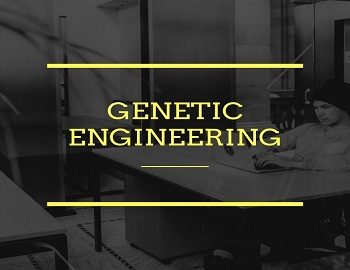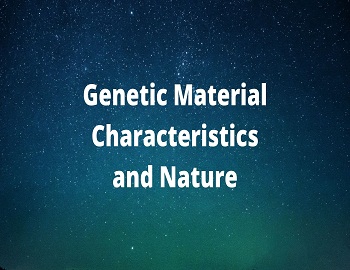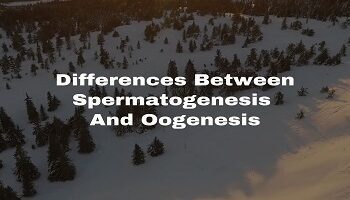Table of Contents
What is Genetic Engineering?
Genetic Engineering is DNA manipulation technology that produces and modifies DNA sequences for creating cells, tissues, organs and individuals to suit human requirements.
Aims of Genetic Engineering:
- Unravelling molecular events in biological processes.
- Cloning genes.
- Cloning organisms.
- Producing transgenic or genetically modified organisms (GMOs)- animals, plants and microbes.
- Obtain genetically modified foods.
- Synthesize desired human gene products.
- Obtain pharmacologically and therapeutically useful products.
- To replace deleterious genes with normal or useful genes in gene therapy so as to treat incurable hereditary disorders.
- DNA finger-printing.
- Study the human genome in details so as to know the number and functioning of each gene.
Tools of Genetic Engineering:
Genetic engineering which involves isolation of a gene segment from the whole genome, cloning of the gene into multiple copies and their expression needs several biological tools. Some of them are given below-
Enzymes:
- Exonucleases.
- Endonucleases.
- Restriction endonucleases.
- SI enzymes to convert the cohesive ends of single stranded DNA fragments into blunt ends.
- DNA ligases.
- Alkaline phosphatase.
- Reverse transcriptase.
- DNA polymerase.
Passenger DNA / Foreign DNA:
It is a fragment of DNA molecule, which is to be enzymatically isolated and cloned.
Cloning vectors:
Vectors or vehicle DNA are those DNA that can carry a foreign DNA fragment when inserted into it. The vectors generally used are bacterial plasmids and bacteriophages.
Benefits of Genetic Engineering in Crop Improvement:
Genetic Engineering has been successfully used in agriculture to improve crop plants. Following are the benefits of genetic engineering in crop improvement-
- It is possible to transfer nitrogen-fixing genes from bacteria or blue-green algae to the major crops so that they become self-sufficient in fixing atmospheric nitrogen. This will definitely increase food production and involve the saving of expensive synthetic fertilizers. For example- conversion of cereals into nitrogen-fixing plants by transferring lectin (a protein that enables bacterial invasion of root tissues) genes and leghemoglobin (a protein which protects the fixed N2 against O2 which will otherwise cause oxidation) and by converting chloroplast into nitroplasts with the help of nitrogen-fixing genes.
- It may be possible to produce plants of desirable characters by artificially synthesizing the known sequence of nucleotides.
- Transfer of resistance against pathogens and pests, from weeds to crop plants.
- Elimination of unwanted genes for susceptibility to different diseases.
- Improvement of photosynthetic efficiency by reassembling nuclear and chloroplast genes from the best sources and by the possible conversion of C3 plants to C4 plants.
- Improvement in quality and quantity of seed proteins and transfer of genes for animal proteins to crop plants.
- Development of cell lines, which may produce nutritious food in bioreactors.
Applications of Recombinant DNA Technology:
- The technology is used in the study of molecular events of various developmental stages like cellular differentiation, morphogenesis, agening etc.
- rDNA technology can be employed to make gene maps.
- Genetically engineered bacteria are employed to synthesize certain vital life-saving drugs, hormones and antibiotics Example- Antiviral/anticancer interferons, human growth hormone (HGH), somatostatin, etc.
- Genetically engineered bacteria are called superbugs. Superbugs can degrade several aromatic hydrocarbons, at the same time. They are employed in clearing oil spills in the ocean. Thus these are used in pollution abatement. The superbug was produced first by an Indian researcher Anand Chakravarthy in the USA. He developed a strain of Pseudomonas bacterium to clear up oil spills. The above superbug can destroy octanes, xylenes camphors and toluenes.
- Gene therapy is the replacement of a defective gene by a normal healthy and functional gene. Gene therapy can overcome the effects of various genetic disorders like sickle-cell anaemia, colour blindness, alkaptonuria, muscular dystrophy, SCID (severe combined immunodeficiency) etc.
- Disputed parentage can be more accurately solved by recombinant technology than by blood tests.
- Genetic Counselling- Prospective parents, who are carriers of genetic disorders, can be advised about the possibility of the inheritance of the disorders by their children. This is done by determining the genotypes of the parents.
Present Constraints of Genetic Engineering:
Though genetic engineering permits a thorough study of the nature and functions of the hereditary material and gives deeper insight into which when and where enzymes are made; yet there are some constraints as well. They are as follows-
- There is a positive danger that the manipulation of genes might by accident result in the origin of new kinds of diseases.
- An organism may contain some fatal genetic elements.
- New recombinants may escape and contaminate the entire earth and may not reveal their presence until their deadly work is done.
- Many antibiotics may become ineffective if the bacteria acquire resistance due to uncontrolled recombinant DNAs.
- The genetic material of eukaryotes is quite complex and knowledge of the location and function of the specific genes in crop plant is so poor that genetic engineering is still problematic.
- Each crop plant contains one to ten million genes and it is quite difficult to study all.
- There is an apprehension that genetic engineering may produce deterioration in the improved food crops.









Comments (No)